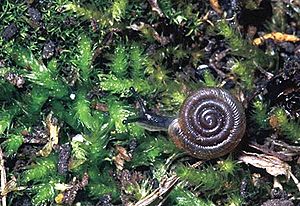Discus macclintocki facts for kids
Quick facts for kids Discus macclintocki |
|
|---|---|
 |
|
| Conservation status | |
| Scientific classification | |
| Genus: |
Discus
|
| Species: |
macclintocki
|
The Iowa Pleistocene snail (scientific name: Discus macclintocki) is a tiny land snail. It lives in parts of Iowa and Illinois in the United States. This special snail is an endangered species. This means it is protected by law because there are very few left.
Contents
Life of the Iowa Pleistocene Snail
This snail lives in very specific places. These spots are called algific talus slopes. Imagine a rocky hillside where cold air and water come out from underground ice. This keeps the ground cool, even in summer. The temperature rarely goes above 50°F (10°C).
The Iowa Pleistocene snail is a "relict" species. This means it's a survivor from the last ice age. That was a time when huge glaciers covered much of the Earth. This snail has lived for a very long time. Scientists have found its fossils from about 400,000 years ago!
Most of these snails live in the Driftless Area. This is a special region in Iowa, Illinois, Minnesota, and Wisconsin. It's called "Driftless" because glaciers didn't cover it. So, it kept its unique landscape.
What the Snail Eats and Does
The snail eats leaf litter from trees and shrubs. It especially likes leaves from birch, maple, and dogwood trees.
In winter, the snail burrows underground. It becomes dormant, which means it goes into a deep sleep. This helps it survive the cold.
The snails breed from March to August. A female snail lays two to six eggs in the leaf litter. The baby snails hatch in about 28 days. These snails can live for 5 to 7 years. An adult snail is very small. It is only about 5 to 8 millimeters wide. Its shell is usually brownish or greenish.
Protecting the Iowa Pleistocene Snail
For a while, people thought the Iowa Pleistocene snail was extinct. But in 1955, a scientist found it again in northeastern Iowa! Because it was so rare, the United States listed it as an endangered species in 1978.
Why the Snail is in Danger
The biggest threat to this snail is climate change. The snail needs very cold places to live. As the world gets warmer, these special cold spots are shrinking. The snail is a true "ice age survivor."
Since 1850, about 75% of the snail's original habitat has been destroyed. Other things that hurt the snail's home include:
- logging (cutting down trees)
- quarrying (digging for rocks)
- livestock (farm animals like cows)
- pesticides (chemicals used to kill pests)
- Building roads
- shrews (small animals that sometimes eat snails)
The International Union for the Conservation of Nature (IUCN) also checks on animals. They have listed the Iowa Pleistocene snail as a "species of least concern." This is because its numbers seem stable. No known populations were lost in the ten years before their check.
Driftless Area National Wildlife Refuge
The Driftless Area National Wildlife Refuge was created in 1989. It covers about 775 acres (3.1 km²). Its main job is to protect native plants and animals. This includes endangered species like the Iowa Pleistocene snail.
The refuge helps save the snail's special algific talus slope habitat. It also protects other cool, moist areas like sinkholes.
Other Rare Species at the Refuge
Other rare snails from the ice age live here too. One example is the Midwest Pleistocene vertigo (Vertigo hubrichti).
Rare plants also grow in the refuge. The northern blue monkshood (Aconitum noveboracense) is one. It also loves the cool, rocky habitat where the snail lives.



